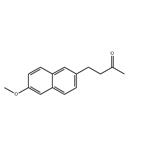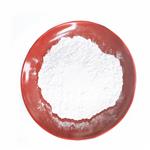- Nabumetone
-

- $0.00 / 1kg
-
2024-04-26
- CAS:42924-53-8
- Min. Order: 1kg
- Purity: 99.0%
- Supply Ability: 1tons
- Nabumetone
-

- $0.00 / 25KG
-
2023-08-30
- CAS:42924-53-8
- Min. Order: 1KG
- Purity: 99%
- Supply Ability: 50000KG/month
- Nabumetone
-

- $1.90 / 1KG
-
2023-03-06
- CAS:42924-53-8
- Min. Order: 1KG
- Purity: 99%
- Supply Ability: 10 ton
|
| | Nabumetone Basic information |
| | Nabumetone Chemical Properties |
| Melting point | 80-810C | | Boiling point | 330.1°C (rough estimate) | | density | 1.0657 (rough estimate) | | refractive index | 1.5542 (estimate) | | storage temp. | Sealed in dry,2-8°C | | solubility | Soluble in alcohol or chloroform | | color | White | | Water Solubility | 6mg/L(22.5 ºC) | | BCS Class | 2/4 | | CAS DataBase Reference | 42924-53-8(CAS DataBase Reference) | | NIST Chemistry Reference | Nabumetone(42924-53-8) |
| Hazard Codes | Xn | | Risk Statements | 22-40 | | Safety Statements | 36/37 | | WGK Germany | 2 | | RTECS | EL9085000 | | HS Code | 2914500000 |
| | Nabumetone Usage And Synthesis |
| Description | Nabumetone is a non-acidic, nonsteroidal antiinflammatory agent formally related
to naproxen. Its main circulating metabolite is 6-methoxy-2-naphthylacetic acid
(α-nornaproxen). Administered once daily (Tsub>1/2 * 30 hrs), nabumetone is reported
to be effective in the treatment of rheumatoid and osteoarthritis. | | Chemical Properties | White Powder | | Originator | Beecham (United Kingdom) | | Uses | anesthetic (local) | | Uses | Anti-inflammatory. Antibacterial. | | Uses | Anti-inflamatory. Antibacterial | | Uses | Nabumetone is an anti-inflammatory and antibacterial agent (1). A non-steroidal anti-inflammatory prodrug used for treatment of inflammatory and degenerative rheumatic diseases. | | Indications | Nabumetone (Relafen) is approved for rheumatoid
arthritis, osteoarthritis, and pain management. Its long
half-life allows for once-daily dosing. Although this
drug is a weak inhibitor of COX, it is metabolized in the
liver to 6-methoxy-2-naphthylacetic acid (6-MNA), a
strong COX inhibitor that is chemically similar to
naproxen. As with most NSAIDs, GI side effects are
most commonly reported. The incidence of gastric ulceration
is lower with nabumetone than with many
other NSAIDs.This is due to its nature as a prodrug, not
to COX-2 selectivity. Lower-bowel complaints, rashes,
and CNS disturbances are common adverse effects. | | Definition | ChEBI: A methyl ketone that is 2-butanone in which one of the methyl hydrogens at position 4 is replaced by a 6-methoxy-2-naphthyl group. A prodrug that is converted to the active metabolite, 6-methoxy-2-naphthylacetic acid, following oral administration. It is s
own to have a slightly lower risk of gastrointestinal side effects than most other non-steroidal anti-inflammatory drugs. | | Manufacturing Process | 4-(5-Bromo-6-methoxy-2-naphthyl)-4-hydroxybut-3-en-2-one
50 grams (0.179 moles) of 2-acetyl-5-bromo-6-methoxynaphthalene and 200
ml of n-butyl acetate are placed in a flask equipped with refrigerator and
stirrer and, under stirring and at the temperature of 15°C, 14.5 g (0.268
moles) of sodium methoxide are added. The temperature of the reaction
mixture goes up to 25°C and is kept at this value for 30 minutes, then the
mixture is warmed at 65°C for one hour, is added with 100 ml of water and is
brought to pH 4 by adding a concentrated aqueous solution of hydrochloric
acid. The reaction mixture is then cooled to 0°-5°C and kept at this
temperature for one hour. The solid is filtered, abundantly washed with water
on the filter, then washed with butyl acetate and dried in oven under vacuum
obtaining 53 g of product with a yield equal to 92%.
Example 1. 4-(6-Methoxy-2-naphthyl)butan-2-one
48 grams (0.150 moles) of 4-(5-bromo-6-methoxy-2-naphthyl)-4-hydroxybut-
3-en-2-one, 6.1 g of sodium acetate hydrate containing 32.4% of water,
equivalent to 0.050 moles of sodium acetate, 4 g of a 50% suspension in
water of 10% palladium on carbon, equivalent to 0.0019 moles of palladium,
and 500 ml of methanol are put in a hydrogenator. The hydrogenator is
washed with nitrogen in order to eliminate the oxygen and then hydrogen is
introduced at the pressure of 2 atmospheres. The temperature of reaction is kept at 40°C for a period of time of 6 hours, then the hydrogen is let off, the
hydrogenator is washed with nitrogen and the reaction mixture is filtered to
eliminate the catalyst. The solution is brought to pH 6 with a 5% aqueous
solution of sodium hydroxide and concentrated under vacuum. The oily
residue is dissolved into 130 ml of isopropanol and 30 ml of N,N�dimethylformamide and the solution is added with 45 ml of water and 17.6 g
of sodium bisulfite obtaining a suspension that is stirred for one hour at 60°C,
then is cooled to 5°C and is filtered. The obtained solid is washed with 75 ml
of methanol, suspended in 200 ml of a 5% aqueous solution of sodium
hydroxide and kept under stirring at room temperature for three hours. The
suspension is then filtered, the solid is washed with water until neutrality and
dried in oven under vacuum obtaining 18 g of product with a yield equal to
52.8%.
Example 2. 4-(6-Methoxy-2-naphthy)butan-2-one
The reaction described above is repeated with the sole changes of doubling
the amount of sodium acetate hydrate containing 32.4% of water, 12.22 g
equivalent to 0.100 moles of sodium acetate, and of lowering the
hydrogenation time to five hours. In this way 22.5 g of product are obtained
with a yield equal to 66%.
Example 3. 4-(6-Methoxy-2-naphthyl)butan-2-one
The reaction described in example 3 is repeated with the sole changes of
nearly triplicating the amount of sodium acetate hydrate containing 32.4% of
water, 17.60 g equivalent to 0.145 moles of sodium acetate, and of lowering
the hydrogenation time to five hours. The oil obtained by evaporating the
solvent at the end of the reaction is treated with 300 ml of toluene and 100
ml of water and after 15 minutes of stirring the two layers are separated. The
aqueous phase is discarded while the organic phase is evaporated under
vacuum at 70°C obtaining an oil that is dissolved into 100 ml of methanol.
The solution is kept at 0°C for two hours and the precipitated solid is filtered,
washed with 15 ml of methanol cooled to 0°C and dried in oven under
vacuum. In this way 21.7 g of product are obtained. The methanolic filtrates
from crystallization and washing are concentrated under vacuum to half
volume so obtaining, after cooling to 0°C, the crystallization of other 4 g of
product with an overall yield equal to 75.3%. | | Brand name | Relafen (Smith-Kline Beecham);RELIFEX. | | Therapeutic Function | Antiinflammatory | | General Description | Nabumetone (Relafen), a nonacidic NSAID prodrug, isclassified as an arylacetic acid, because it undergoes rapidhepatic metabolism to its active metabolite, 6-methoxy-2-naphthylacetic acid. Similar to the other arylacetic aciddrugs, it is used in short- or long-term management of RAand OA. Being nonacidic, it does not produce significantprimary insult to the GI mucosa lining and also has no effecton prostaglandin synthesis in gastric mucosa, thus producingminimum secondary GI damage when comparedwith other conventional NSAIDs. | | Pharmacokinetics | Nabumetone is absorbed primarily from the duodenum. Milk and food increase the rate of absorption and the
bioavailability of the active metabolite. Plasma concentrations of unchanged drug are too low to be detected in most
subjects after oral administration, so most pharmacokinetic studies have involved the disposition of the active
metabolite. Pharmacokinetic properties are altered in elderly patients, with higher plasma levels of the active
metabolite being noted. Nabumetone undergoes rapid and extensive metabolism in the liver, with a mean absolute
bioavailability of the active metabolite of 38%. The metabolism of nabumetone is illustrated in Figure 36.15. The
major,
most active metabolite is 6MNA, but the initial alcohol metabolite, a minor product, and its esters also possess
significant anti-inflammatory properties. | | Clinical Use | Nabumetone is indicated for the acute and chronic treatment of the signs and symptoms of osteoarthritis and
rheumatoid arthritis. The recommended starting dosage is 1,000 mg as a single dose with or without food. More
symptomatic relief of severe or persistent symp-toms may be obtained at doses of 1,500 or 2,000 mg/day | | Drug interactions | Potentially hazardous interactions with other drugs
ACE inhibitors and angiotensin-II antagonists:
antagonism of hypotensive effect; increased risk of
nephrotoxicity and hyperkalaemia
Analgesics: avoid concomitant use of 2 or more
NSAIDs, including aspirin (increased side effects);
avoid with ketorolac (increased risk of side effects
and haemorrhage).
Antibacterials: possibly increased risk of convulsions
with quinolones.
Anticoagulants: effects of coumarins and
phenindione enhanced; possibly increased risk of
bleeding with heparin, dabigatran and edoxaban -
avoid long term use with edoxaban.
Antidepressants: increased risk of bleeding with
SSRIs and venlaflaxine.
Antidiabetic agents: effects of sulphonylureas
enhanced.
Antiepileptics: possibly increased phenytoin
concentration.
Antivirals: increased risk of haematological toxicity
with zidovudine; concentration possibly increased by
ritonavir.
Ciclosporin: may potentiate nephrotoxicity.
Cytotoxics: reduced excretion of methotrexate;
increased risk of bleeding with erlotinib.
Diuretics: increased risk of nephrotoxicity;
antagonism of diuretic effect; hyperkalaemia with
potassium-sparing diuretics.
Lithium: excretion decreased.
Pentoxifylline: increased risk of bleeding.
Tacrolimus: increased risk of nephrotoxicity. | | Metabolism | Nabumetone is rapidly metabolised in the liver to the
main active metabolite 6-methoxy-2-naphthylacetic
acid (6-MNA). The metabolite is a potent inhibitor of
prostaglandin synthesis.
Excretion of the metabolite is predominantly in the urine. |
| | Nabumetone Preparation Products And Raw materials |
|